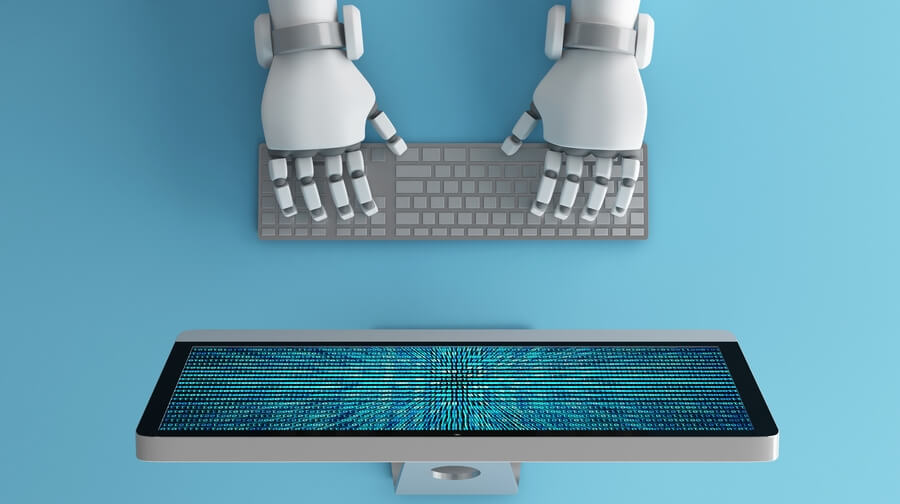Generative AI has been revolutionizing the industry at a fast pace. This post discusses these generative AI trends and how they can be leveraged in SDLC (Software Development Life Cycle) as a force multipliers for software development outsourcing organizations.
While it is still in its infancy, Generative AI and LLMs have the potential to revolutionize the way that software is designed, developed and coded. In this article, we will explore the potential of generative AI for software development and coding, discuss some of the risks of using generative AI for software design and development, and propose how generative AI can become a force multiplier for the software outsourcing industry.
Generative adversarial networks (GANs) and language model-based approaches (LLMs) are two types of generative AI that have gained significant attention in recent years.

Las GAN son un tipo de modelo generativo que consta de dos redes neuronales: un generador y un discriminador. El generador produce datos sintéticos y el discriminador determina si los datos son reales o falsos. Las dos redes se entrenan juntas de manera contradictoria, con el generador tratando de producir datos que no se pueden distinguir de los datos reales y el discriminador tratando de identificar correctamente si los datos son reales o falsos. Las GAN se han utilizado para generar una amplia gama de datos sintéticos, incluidas imágenes, texto y música.
Los LLM son un tipo de modelo generativo que se basa en modelos de lenguaje, que son modelos de aprendizaje automático que están capacitados para predecir la siguiente palabra en una secuencia de palabras. Los LLM se han utilizado para generar texto en lenguaje natural que es similar a un texto de entrada dado o que sigue un mensaje dado. Los LLM también se han utilizado para realizar tareas como traducción, resumen y respuesta a preguntas.
Tanto los GAN como los LLM tienen el potencial de aprovecharse en el proceso de desarrollo de software para mejorar la eficiencia y la productividad. Por ejemplo, las GAN podrían usarse para generar códigos o diseños de interfaz de usuario, y los LLM podrían usarse para generar descripciones en lenguaje natural de los requisitos del software o para generar automáticamente la documentación del código.
AI can be a game changer for software development. The introduction of AI to the SDLC is already significantly impacting everyday software development companies and it seems like things are only moving faster.
The following are some interesting AI applications for various purposes in software development and the common risks associated with them.
ChatGPT:
ChatGPT is a chatbot that uses the GPT-3 language model to generate natural language responses based on a given prompt. In the context of software code development, ChatGPT impacts the way developers work by assisting them in identifying and fixing issues in their code. For example, a developer can ask ChatGPT for suggestions on how to improve the performance of their code, or for assistance in debugging an error. ChatGPT can also be used to generate code documentation based on source code and comments, or to provide code completion suggestions.
GitHub Copilot:
Copilot is an AI tool that can reduce development time, allowing developers to create complete codes based on code examples, semantic hints, and developer comments.
Replit:
Replit is a platform-creating and sharing software allowing developers to write their code and host it simultaneously at the same place. It can replace facilities like code editor, cloud provider, development environment, teaching, learning, and team collaboration tools.
Tabnine:
Tabnine is an AI code completion assistant that reuses an organization’s common coding patterns to make it easy for the developer to work with line code completions directly in IntelliJ IDEA IDEs Visual Studio Code. This auto-complete solution now supports eleven more languages after an AI overhaul.
CodeT5:
CodeT5 is an open- source model created by the Salesforce team. CodeT5 achieves top- level performance on coding tasks, including code defect detection and clone detection.

AI2sql:
AI2sql is an AI-powered SQL builder that helps convert English language statements to SQL queries and retrieve information stored in a database using commands in natural languages.
Debuild:
Debuild is a web app builder that allows developers to create new content by utilizing existing images, video, audio, and text files. The advantage is training AI algorithms to analyze speech samples, facial expressions, and consumer-generated text and understand customer responses.

Documentation AI helps create realistic and accurate text documents. It improves the quality of text-based software tools like search engines, machine translators, and chatbots. For example, the Smart Reply facility in Gmail is an AI tool that helps offer better auto-complete suggestions. Mintlify is another example of the use of AI to generate documentation from code automatically. Stenography is yet another automatic code-based documentation application that combines AI and code parsing techniques to decrease cognitive load.
However, using AI for web building brings risks like unrealistic expectations, unforeseen outcomes, the need for massive data sets,
While AI has the potential to significantly improve the efficiency and productivity of software code development, it is important to carefully consider the limitations and risks of using this technology, such as the potential for biased or inaccurate output, code quality, code performance, malicious code injection, Intelectual property and data privacy concerns. It is also important to ensure that the data used to train the model is diverse and representative, in order to avoid biased or discriminatory outputs.

By carefully considering the potential benefits and risks of using AI in the software development process, software outsourcing organizations can leverage this technology as a force multiplier to increase efficiency and productivity.
If you’re interested in learning more about how generative AI can accelerate your software development and transform your SDLC, don’t hesitate to reach out to the team at Polytropic. Our experienced professionals are here to help you navigate the potential benefits and risks of using generative AI in your organization and understand how it can be leveraged as a force multiplier for your software development outsourcing efforts. Contact us today to discuss your specific needs and explore how generative AI can drive your success.





